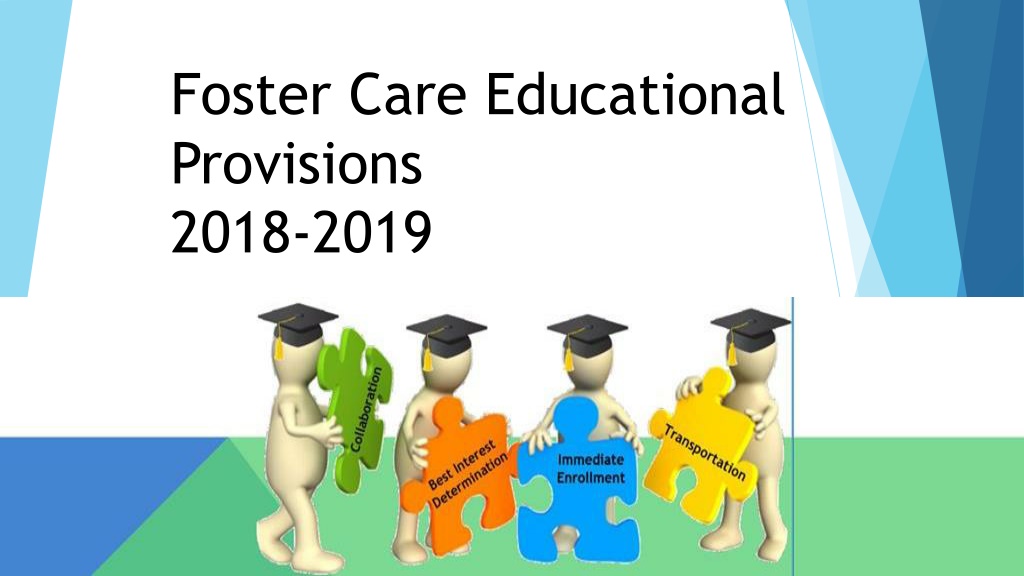Ensuring Educational Stability for Students in Foster Care
Educational stability is crucial for students in foster care to prevent lasting impacts on their academic, social, and emotional well-being. The provisions outlined in Title I Part A ensure specific educational rights and establish points of contact to support these vulnerable students. It is essential to prioritize the school of origin, conduct best interest determinations collaboratively, and involve key stakeholders in decision-making processes. Maximizing educational stability can enhance attendance, minimize gaps in education, and strengthen family connections for students in foster care.
Download Presentation

Please find below an Image/Link to download the presentation.
The content on the website is provided AS IS for your information and personal use only. It may not be sold, licensed, or shared on other websites without obtaining consent from the author. Download presentation by click this link. If you encounter any issues during the download, it is possible that the publisher has removed the file from their server.
E N D
Presentation Transcript
Foster Care Educational Provisions 2018-2019 1
Why Educational Stability Frequent school transitions may have lasting academic, social, and emotional impacts. Maximizing educational stability can improve attendance minimize educational gaps help families stay connected 2
Foster Care - Title I Part A Provisions Ensures educational stability Establishes specific educational rights Requires a district foster care point of contact Requires a state foster care point of contact at both DOE (Amelia Lyons) and DHHS (Bobbi Johnson) 3
Definition of Students in Foster Care Students in 24-hour out-of-home care, placed away from their parents or guardians, and for whom DHHS has placement and care responsibilities Students previously identified as awaiting foster care (in emergency, short term placements) under McKinney-Vento 4
Educational Rights of Students in Foster Care School of Origin and Transportation Best Interest Determination Immediate Enrollment 1. 2. 3. 5
School of Origin School the student was attending when placed in foster care, or at the time of a subsequent change in foster care placement. Students should remain enrolled in their school of origin, unless, after a best interest determination, it is decided to be in their best interest not to. 6
Best Interest Determination (BID) Decisions about which school a student will attend should be made collaboratively, and consider a wide variety of factors Should include those in the best position to understand the student s unique needs Student should remain in their school of origin until the BID is complete 7
Chat: Who should be involved in the Best Interest Determination? 8
Student, parent/guardian, foster parent Educational decision maker, legal representative District POC, special education, guidance counselor, teacher Social worker, education coordinator District POC from district of foster placement 9
Chat: What should we consider when making a best interest determination for school placement? 10
Consider the unique needs of the student, including but not limited to: student s age and grade level; student s preference, when age appropriate; student s attachment to the school, including meaningful relationships with staff and peers; placement of the student s sibling(s); distance/length of time to travel to/from school 11
time of academic year, academic performance, and skills; anticipated length of time in placement, and whether reunification is the family goal; number of placements to date; ability to maintain family relationships and engagement (including in extracurricular activities, where appropriate) 12
clinical/behavioral issues; influence of the school climate on the student, including safety issues; availability and quality of the services in the school to meet the student s educational and social emotional needs; and availability of special education/504 services, if applicable 13
Other Considerations for BID Is the school of origin in the best interest for a limited duration of time? (e.g., until the end of the school year, the end of a testing or grading period, or the end of a particular grade). 14
Other Considerations (contd) Transportation costs should NOT be a factor in determining the best interest. 15
Transportation Districts and DHHS must collaborate to establish policies to ensure students who need transportation to remain in their school of origin can. Absent another agreement, districts of origin are responsible for providing transportation to and from the school of origin. Districts should document all costs associated with this transportation. 16
Chat: What strategies can schools use to provide transportation for highly mobile students? 17
Transportation Strategies Liaise with school and transportation staff, shelter workers School buses (including special education) Formal/informal agreements with districts where homeless children cross district lines Public transit, including supporting parents to travel with younger children Approved carpools, van or taxi services Vouchers for families with access to cars Pursue inter-agency solutions 18
Immediate Enrollment If BID supports attending school locally (where placed in foster care), districts must enroll immediately, with or without documentation, including academic, health, discipline and/or special education records. Notice to LEA (from DHHS), includes emergency contact, residence, social worker, record release, transportation needs, etc. 19
School Selection Disputes After the BID, DHHS has the authority to make final decisions about the best interest, but a school district may dispute. During the dispute resolution process, the student must attend the school selected by DHHS. Transportation must be provided if needed. 20
Role of District Foster Care POC Ensure that students in foster care are: identified and supported through coordination between Districts and DHHS are enrolled in and regularly attending school 21
District Foster Care POC Participate in making and documenting BIDs with DHHS representatives Ensure school enrollment of students and timely transfer of records 22
District Foster Care POC Develop procedures for coordinating cost-effective transportation Facilitate professional development for district staff 23
Questions? 24
Closing For more information, see additional materials posted at tinyurl.com/mainedoe2019 Or contact: Amelia Lyons, Consultant for Highly Mobile and Migratory Students Maine Department of Education Amelia.lyons@maine.gov (207) 624-6722 25

 undefined
undefined























